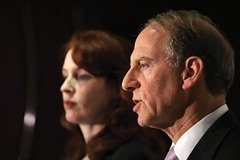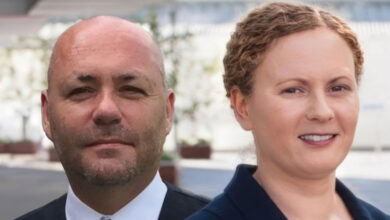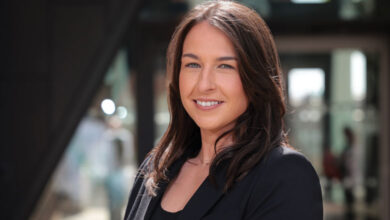The Haass proposals
 Peter Cheney summarises the main points in Richard Haass’ proposed agreement on flags, parades and the legacy of the Troubles.
Peter Cheney summarises the main points in Richard Haass’ proposed agreement on flags, parades and the legacy of the Troubles.
The Haass process produced 40 pages of proposals but no political agreement. Unlike previous negotiations, the talks did not directly involve the British and Irish governments and there was no realistic penalty for failure. The prospect of elections less than six months away also limited the potential for a deal.
The flags dispute was the main reason for setting up the Haass process but also the main area where consensus was not reached. Several options were considered, including designated days, a return to permanent flag-flying at Belfast City Hall, a potential new regional flag and the use of the tricolour during Irish presidential visits to Northern Ireland.
Haass therefore opted for a ‘commission on identity, culture and tradition’ i.e. seven elected representatives (nominated by the Executive parties), eight from outside government and either a chair or two co-chairs (all appointed by OFMDFM). It would hold “structured discussions” in public over the course of a year and then report back to the First Minister and deputy First Minister.
Parades
Much of Haass’ proposed agreement deals with parades, select commemorations and related protests. A select commemoration is one which marks “an event of public significance” in Northern Ireland or one which has a “clear connection” to the province.
To succeed the Parades Commission, Haass suggests an ‘office for parades, select commemorations and related protests’ and an ‘authority for public events adjudication’ – an independent regulator.
Applications for a parade or select commemoration would be submitted to the office 25-30 working days in advance. The organisers would be responsible for limiting participation to the listed groups and individuals, making all participants aware of the code of conduct and any conditions, and discouraging law-breaking behaviour.
Exemptions for funerals would naturally apply and could be extended to other events. For example, Salvation Army parades are already exempt as they are non-contentious.
Face-to-face dialogue is encouraged and details of the application would be published within two working days of its being submitted. The office would then allow another five days to lodge protests and a further five days for mediation. The office could refer the parties to professional mediators, on request, but would not become directly involved.
Late applications and outstanding disputes would be referred to the independent regulator. This body would have seven members: a chair from the legal profession (appointed by the Northern Ireland Judicial Appointments Commission) and six others (appointed by the First Minister and deputy First Minister).
The regulator would give the parties three working days to submit their views and it would then have three working days to discuss the situation. Determinations would be made by a majority vote. In exceptional cases, the regulator would have the power to ban a parade but only if this were necessary to “adequately safeguard community relations and public order.”
A code of conduct was the most contentious part of the parades section. The code would oblige parade participants and protestors to: respect determinations; avoid threatening, provocative, abusive, sectarian, obscene, or racist words or behaviour; behave sensitivity at interfaces, places of worship, war memorials and cemeteries; and reject paramilitary-related marks, music or clothing.
Legacy
The Consultative Group on the Past, led by Robin Eames and Denis Bradley, published its report in January 2009. This was rejected by unionist parties over a proposed acknowledgment payment to bereaved families – which would have included those connected to paramilitaries.
Five years on, the Haass agreement warns that “memories are fading and people are passing away” thus making a resolution more difficult. Its first priority is that all those affected by violence receive appropriate care and an efficient response from the Victims and Survivors Service. A ‘mental trauma service’ was proposed but, as expected, there was no agreement on the definition of victim.
There are currently four processes for reviewing ‘cold cases’ from the Troubles: Historical Enquiries Team investigations; Police Ombudsman investigations; coroners’ inquests; and public inquiries established by the UK and Irish governments.
This “multiplicity” of processes creates confusion and places “enormous burdens” on the police. Coroners’ inquests must remain in place as their independence is protected by European human rights law. Likewise, the governments should be free to decide when to establish inquiries.
Haass suggests a new ‘historical investigations unit’ which would take on records from completed HET and Police Ombudsman cases and investigations that have not yet started, again with a view to taking prosecutions. Investigations already commenced by the PSNI should be completed by the PSNI.
Where an investigation does not lead to a prosecution, the family could receive a report explaining the extent of information that is known about the case. Relatives who did not wish to pursue a prosecution would be able to take their case to an ‘independent commission for information retrieval’ led by an international figure.
In this process, families would be able to register a request for information. The commission would then approach paramilitary groups or the two governments through intermediaries and ask those responsible to provide information.
The commission’s staff would then question witnesses in detail about the incident. A private report would then go back to the family. Information could also be volunteered to the commission. Any information provided through these processes would be inadmissible in court but prosecutors would still be free to pursue cases by using admissible evidence. Families could also take action for civil damages.
A witness may name other people who, according to him or her, were also involved in a killing. The commission would “never inform law enforcement of these claimed links” but would ask the named individuals to confirm or deny their alleged involvement.
This process also has the potential to divide families as some relatives will still want a prosecution. If a family were divided, the commission would pursue information on behalf of those relatives who wished to receive it.
The Executive would also establish an archive of the Troubles, which would record personal narratives. This archive would initially be available online but later be stored in a physical building.
A ‘historical timelime group’ was also proposed in order to develop a factual chronology of the conflict between 1968 and 1998. This would be made up of suitably qualified academics. The Eames-Bradley commission had extended that period back to 1966, to include the first paramilitary attacks. Families of those killed by paramilitaries since 1998 want their cases to be given attention as well.
An independently-led ‘implementation and reconciliation group’ would include representatives from Executive parties and other interest groups. Implementing the proposals would involve a substantial – but unspecified – cost, primarily met through the Executive’s own budget. Haass envisages additional support coming from the governments and the European Union.
The University of Ulster’s CAIN project records that 3,531 people lost their lives in the Troubles. 3,272 deaths occurred in Northern Ireland and 259 in Britain, the Republic and Europe. Around 3,000 of these cases remain unsolved.
The Haass paper has been published at www.northernireland.gov.uk and the Eames-Bradley report is available via cain.ulst.ac.uk/events/peace/soc.htm





